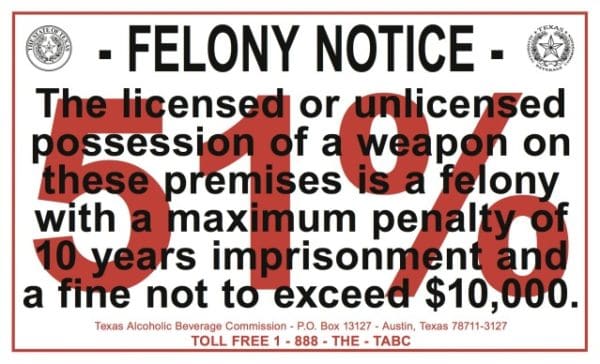ScottDLS wrote:Keith B wrote:
....
While you are technically correct, one thing to remember is this is a 'defense to prosecution', but not a guarantee you won't be prosecuted. For example, if the prosecutor can convince the Judge or Jury that you well knew it was a 51% location when you entered, even without the sign, then you could be in hot water and be convicted of carrying in a 51% establishment.
So, I would still be very cautious if you suspicion an establishment is 51% even without the sign unless you have proof it is not.
Two points.
First. Charles Cotton has said in a previous post that by case law
all the 46.15 Non-Applicability Provisions are considered a "Defense to Prosecution" vs. an exception to the law. That means carrying
at all with a CHL or even carry by a Peace Officer is a "only" Defense to Prosecution.
Second. The Defense provided under 46.035 can't be negated by proving that you "knew" it was a 51% location. The Defense is that you were not given effective notice under section GC 411.204 (by posting of a 51% sign). If you present evidence of your Defense at trial, the prosecution must prove "beyond a reasonable doubt" that the Defense didn't exist.
There is an interesting sideline to this the defense of improper notification.
It seems intuitive that the reason for specific rules for notification is to ensure the end result of you actually being in a state of knowledge of the thing that the notification is intended to convey. In other words, the purpose of .204 is to ensure you know about the 51% status of the establishment you are about to enter.
Why do this? It also seems obvious the the point of making this ensurance is to allow you to effective comply with the prohibition in 46.035. Now, if this is true...it follows that if a prosecutor can prove that you were already in a state of knowledge of the 51% status of the business then the violation of 46.035 was committed while in that state of knowledge. This might negate the defense offered in .204.
Again, the defense to prosecution in .204 is that you were not informed. But if you were in fact informed already and that can be proven then the question becomes, "did you or did you not know that you were violating 46.035 at the time. The fact that notification is required in .204 implies that failure to notify gives you a defense. The reverse implication is that if one is already informed, that the foreknowledge implied in .204 requires is essentially present and the defense offered therein is non-effectual.
In fact, this might be applicable in any situation where there is a requirement of notification such as 30.05, .06, and .07...and any other statutes where there is notification required in any code.
This would explain why a judge might not accept a defensive argument "I'm not guilty because I wasn't notified properly" even though it was PROVEN that the defendant actually knew.
This is the difference between defense to prosecution and exception to prosecution or affirmative defense to prosecution.
tex

